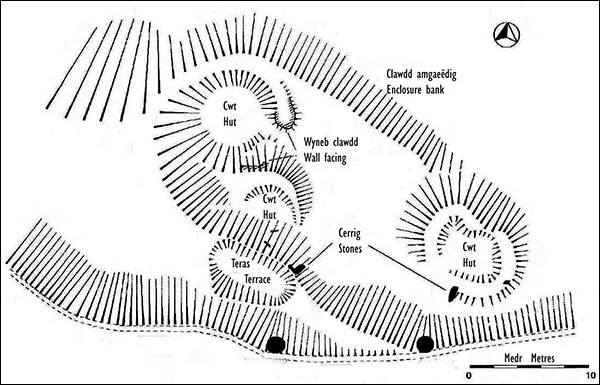Prehistoric huts site, Borth-y-Gest, Porthmadog
![]() The main footpath through the mature oak woodland known as Parc y Borth skirts the southern edge of an Iron Age or Romano British settlement. There are clear remains of three huts, and the site is locally known as Tai Crwn (“roundhouses”).
The main footpath through the mature oak woodland known as Parc y Borth skirts the southern edge of an Iron Age or Romano British settlement. There are clear remains of three huts, and the site is locally known as Tai Crwn (“roundhouses”).
The site is a Scheduled Ancient Monument and is rare because of its lowland position. Usually the remains of prehistoric roundhouses are found on higher ground, often within or near hillforts.
 Here the hut remnants are on a small terrace on the slope, as shown in the map courtesy of Gwynedd Archaeological Trust. A low earth bank around the site forms a roughly oval enclosure, 36x42 metres. The northernmost hut was c.7.5 metres in diameter inside. At the eastern end of the site stood a hut of c.6x4 metres. The third hut may have been about the same size, but its base is partly obscured by material tipped when a newer terrace was created a little further up the slope.
Here the hut remnants are on a small terrace on the slope, as shown in the map courtesy of Gwynedd Archaeological Trust. A low earth bank around the site forms a roughly oval enclosure, 36x42 metres. The northernmost hut was c.7.5 metres in diameter inside. At the eastern end of the site stood a hut of c.6x4 metres. The third hut may have been about the same size, but its base is partly obscured by material tipped when a newer terrace was created a little further up the slope.
The drawing by Cathy Woodhead of Borth-y-Gest shows how the settlement might have looked. The area’s vegetation would have been very different 2,000 or more years ago.
 Excavation of the site in the 1920s revealed a flint nodule (a type of stone which humans used for making tools or starting fires) and a pot-boiler (a stone which was heated by fire and dropped into liquids to heat or boil them). There were also fragments of iron ore, indicating that primitive metal-making may have occurred locally.
Excavation of the site in the 1920s revealed a flint nodule (a type of stone which humans used for making tools or starting fires) and a pot-boiler (a stone which was heated by fire and dropped into liquids to heat or boil them). There were also fragments of iron ore, indicating that primitive metal-making may have occurred locally.
Work to protect and enhance the biodiversity of Parc y Borth local nature reserve was undertaken in 2023-24, including interpretation and access work, wildflower meadow and woodland management, tree planting and establishment of a community orchard. The work was facilitated by the Local Nature Partnership in Gwynedd and the Welsh Government’s Local Places for Nature fund, in partnership with the local authority and reserve manager Cyngor Gwynedd.
With thanks to Gwynedd Archaeological Trust and Cathy Woodhead



